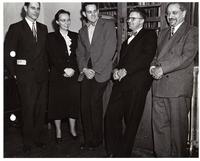(9,481 - 9,500 of 10,078)
Pages
-

-
Title
-
W.A. Kerr, Harriet C. Shurrager, R.A. Dykman, Dr. Phil S. Shurrager, and Dr. David Boder, Department of Psychology, Illinois Institute of Technology, Chicago, Illinois, ca. 1950
-
Date
-
1950
-
Description
-
Photograph of Illinois Tech Department of Psychology faculty and Dean: (left to right) Willard A. Kerr, Harriett C. Shurrager (Associate...
Show morePhotograph of Illinois Tech Department of Psychology faculty and Dean: (left to right) Willard A. Kerr, Harriett C. Shurrager (Associate Professor Emeritus), Roscoe A. Dykman, Dr. Phil S. Shurrager (Dean of Psychology and Education), and Dr. David Pablo Boder (Professor Emeritus). Photographer unknown. Date of photograph is unknown. Date range listed is approximate.
Show less
-
Collection
-
Department of Psychology photographs, 1950-1972
-

-
Title
-
Illinois Tech March Song
-
Date
-
1964
-
Description
-
Sheet music for "Illinois Tech March Song," composed by William C. Laube, Jr. in 1949, when he when he was an undergraduate at Illinois Tech....
Show moreSheet music for "Illinois Tech March Song," composed by William C. Laube, Jr. in 1949, when he when he was an undergraduate at Illinois Tech. Laube was not able to publish the song in 1949, but was it was discovered in a music file in 1964 by Illinois Tech music director H.E. Nutt, arranged for the IIT band, and played at that year's Homecoming, and other university events. This printed sheet music is assumed to date from that era, though the circumstances of its creation are uncertain.
Show less
-
Collection
-
IIT Songs collection, 1940-2002
-

-
Title
-
The Blue Flame, Bonneville Salt Flats, Utah, 1970
-
Date
-
1970
-
Description
-
Transparency depicting the car known as the Blue Flame that set the land speed record on October 23, 1970 at Bonneville Flats, Utah. Powered...
Show moreTransparency depicting the car known as the Blue Flame that set the land speed record on October 23, 1970 at Bonneville Flats, Utah. Powered by ignited liquefied natural gas, the car was conceived by Illinois Institute of Technology Research Institute colleagues Dick Keller and Ray Dausman and constructed by Reaction Dynamics, Inc. in Milwaukee. Henry R. Linden, then President of the Institute of Gas Technology, obtained the funding for the project and assembled a team of Illinois Tech engineering students and faculty members T. Paul Torda and Sarunas C. Uzgiris to improve the aerodynamics of the car. In October, 1970, with Gary Gabelich driving, The Blue Flame set a land speed record of 1,014 km/h, a record that stood for 27 years. Original photographer unknown.
Show less
-
Collection
-
Office of Communications and Marketing photographs, 1905-1999
-

-
Title
-
Josephine Mehlberg, ca. 1960
-
Date
-
1960-1969
-
Description
-
Photograph of Professor Josephine Mehlberg teaching a mathematics class. Photographer was possibly Dan Ryan. Date of photograph is unknown....
Show morePhotograph of Professor Josephine Mehlberg teaching a mathematics class. Photographer was possibly Dan Ryan. Date of photograph is unknown. Date range listed is approximate.
Show less
-
Collection
-
Dan Ryan collection, 1954-1980
-

-
Title
-
Sidney Guralnick, Illinois Institute of Technology, Chicago, Illinois, ca. 1970s
-
Date
-
1970-1979
-
Description
-
Photograph of Sidney Guralnick at a window in Perlstein Hall, looking south towards S.R. Crown Hall and IITRI Tower. Sidney A. Guralnick was...
Show morePhotograph of Sidney Guralnick at a window in Perlstein Hall, looking south towards S.R. Crown Hall and IITRI Tower. Sidney A. Guralnick was Dean of the Graduate School at Illinois Institute of Technology, and later the university's first Provost, appointed by President Thomas L. Martin, Jr. in 1975. Since 1982, he has served as Perlstein Distinguished Professor (now Emeritus) in the department of Civil & Architectural Engineering. Photographer unknown. Date of photograph unknown. Date range listed is approximate.
Show less
-
Collection
-
Office of Communications and Marketing photographs, 1905-1999
Pages